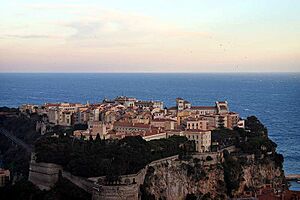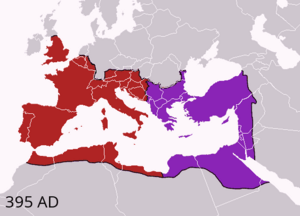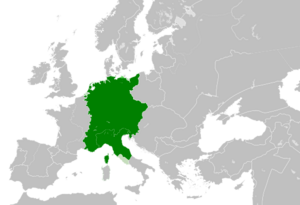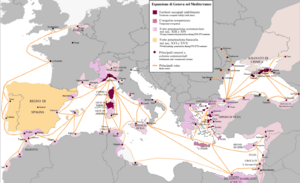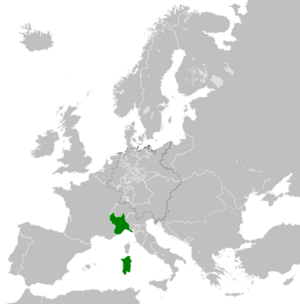History of Monaco facts for kids
The early history of Monaco is mostly about the Rock of Monaco. This big rock was a safe place for ancient people. Later, it became a strong fortress. Monaco was part of Liguria after the Roman Empire fell. From the 1300s to the early 1400s, different groups fought over the area for political reasons. Since then, except for a short time when France took control, the House of Grimaldi family has ruled Monaco.
Contents
- Early Settlers and Ancient Ligurians
- Phoenicians and the God Melqart
- Greek Settlers and the Legend of Heracles
- Monaco Under Roman Rule
- From the Middle Ages to Genoese Control
- The Rise of the Grimaldi Family
- Under the Kingdom of Sardinia
- Monaco in the 19th Century
- Monaco in the 20th Century
- Monaco in the 21st Century
- See also
Early Settlers and Ancient Ligurians
About 30,000 years ago, a very early human, sometimes called "Grimaldi man," lived here.
Historians say that the first people to live permanently in this area were the Ligures. They were mountain people who came from Genoa in northern Italy. The old Ligurian language is not like the modern Ligurian language spoken today. The Monégasque dialect is a form of modern Ligurian.
Phoenicians and the God Melqart
Some experts believe that the ancient Phoenicians were the first traders to use the port of Monaco. They found it a safe place from strong sea winds. The Phoenicians made the Port and Rock of Monaco sacred to their god, Melqart. They called their colony Monoike. After the Phoenicians, the Greeks wrote about the journeys of Heracles. Local Ligurian people also believed that Heracles passed through the area.
Greek Settlers and the Legend of Heracles
In the 6th century BC, people from Massalia (which is now Marseille in France) started a colony called Monoikos. This name came from how much they respected the Greek hero Heracles. The Romans later also honored him. People said Heracles built an old path that went through the region from Spain to Italy. The Roman emperor Julian also wrote that Heracles built Monaco's port and a road along the coast. This road had altars (special places for worship) for Heracles. A temple for him was also built on the Rock of Monaco. The old port was later called Port Hercules. The name Monoeci or Monoikos might mean "Single One" or "Single House." This could refer to Heracles, his temple, or the small community living near the rock.
Both Greeks and the local Ligurian people believed that Heracles traveled through this area.
Monaco Under Roman Rule
After the Gallic Wars, Monoecus became part of the Roman Empire. It was a stopping point for Julius Caesar when he traveled to Greece. Monaco was part of the Roman province called Maritime Alps.
The Roman writer Pliny the Elder mentioned the port in his book Natural History. The historian Tacitus also wrote about it in his Histories.
From the Middle Ages to Genoese Control
Monaco stayed under Roman control until the Western Roman Empire fell in 476 AD. After that, different groups ruled the city, including the Ostrogoths and the Lombards. Monaco was damaged by Saracen invaders in the 700s. Monks from Saint-Pons in Nice later rebuilt it. The city was damaged again by Saracen raids.
In the 11th century, Monaco was mentioned again when the church of St. Mary was built. A small town grew up around it.
In 1191, the Holy Roman Emperor Henry VI gave control of the area to the city of Genoa. On June 10, 1215, a group from Genoa started building a fortress on the Rock of Monaco. This date is often seen as the start of Monaco's modern history.
The Genoese wanted their fortress to be a strong military base. They started a settlement around the rock to support the soldiers. To get people to move there, they offered land and no taxes to new settlers.
The Rise of the Grimaldi Family
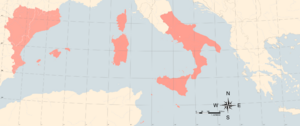
The House of Grimaldi was an old and important family from Genoa. They were part of a group called the Guelphs. There was a civil war in Genoa between the Guelphs and another group called the Ghibellines. Members of the Grimaldi family, along with other Guelph families, found safety in Monaco.
Francesco Grimaldi took control of the Rock of Monaco in 1297. This was the start of the Grimaldi family ruling Monaco, though it was still under the Republic of Genoa. The Grimaldis gained control of Menton in 1346 and Roquebrune in 1355, making their territory larger. In 1338, Monaco's ships, led by Carlo Grimaldi, joined ships from France and Genoa in a naval battle in the English Channel. They brought back treasures from the attack on Southampton, which helped Monaco become richer.
Honoré II, Prince of Monaco made sure that Spain recognized Monaco as an independent country in 1633. Then, Louis XIII of France also recognized its independence in the Treaty of Péronne (1641). Since then, the Grimaldi family has ruled Monaco. The only exception was during the French Revolution from 1793 to 1814, when France took control.
Under the Kingdom of Sardinia
Monaco became independent again in 1814. But in 1815, the Congress of Vienna made it a protectorate of the Kingdom of Sardinia. This meant Sardinia would protect Monaco. This arrangement lasted until 1860. At that time, Sardinia gave the nearby areas of Nice and Savoy to France.
During this time, Italian was the official language of Monaco. The Monégasque dialect is more like the Ligurian language than French, but it has been influenced by both.
There was some trouble in the towns of Menton and Roquebrune. They wanted to be independent and join Sardinia. This unrest continued until the ruling prince gave up his claim to these two towns. They made up about 95% of Monaco's land. These towns were given to France in exchange for four million francs. This agreement and Monaco's independence were confirmed by the Franco-Monegasque Treaty of 1861.
Monaco in the 19th Century
After Napoleon's defeat, the Congress of Vienna in 1815 made Monaco a protectorate of the Kingdom of Sardinia. Monaco's independence was confirmed by the Franco-Monegasque Treaty of 1861. France accepted Monaco as a country. However, France took 95% of Monaco's old territory, which included Menton and Roquebrune. Since then, France has been responsible for Monaco's military defense.
The Monte Carlo Casino opened in 1863. It was run by a company that also managed the Hôtel de Paris Monte-Carlo. The taxes paid by this company helped build up Monaco's infrastructure. Monaco's economy grew quickly in the late 1800s, especially after a railway line connected it to France.
Monaco in the 20th Century
The Prince of Monaco was an absolute ruler, meaning he had all the power. But the Monegasque Revolution of 1910 forced him to create a constitution in 1911. A constitution is a set of rules for how a country is governed.
In July 1918, a treaty was signed that gave France limited protection over Monaco. This treaty was included in the Treaty of Versailles. It stated that Monaco's policies would match France's political, military, and economic interests. One reason for this treaty was a concern about who would rule Monaco next.
Prince Louis II strongly supported France. He tried to keep Monaco neutral during World War II. However, he supported the Vichy French government, which was led by his old army friend, Marshal Philippe Pétain.
Monaco faced problems at home because Prince Louis was unsure what to do. Also, most of the people in Monaco had Italian backgrounds. Many of them supported the fascist government of Italy's Benito Mussolini.
On November 11, 1942, the Italian Army invaded and occupied Monaco.
Soon after, in September 1943, after Mussolini's government fell, the German Army occupied Monaco. They began to deport Jewish people.

One of them was René Blum, a French Jew who started the Ballet de l'Opera in Monte Carlo. He was arrested in Paris and sent to a camp before being taken to Auschwitz concentration camp, where he died. Blum's colleague, Raoul Gunsbourg, who directed the Opéra de Monte-Carlo, escaped with help from the French Resistance. In August 1944, the Germans executed René Borghini, Joseph-Henri Lajoux and Esther Poggio, who were leaders of the Resistance.
Secretly, Prince Louis ordered the Monaco police to warn people whom the Gestapo planned to arrest. This was very risky for the police. German troops left Monaco, and the country was freed on September 3, 1944.
Prince Rainier III became the ruler after his grandfather, Prince Louis II, died in 1949.
A new Constitution of Monaco was created in 1962. It ended the death penalty and gave women the right to vote. It also set up a Supreme Court to protect basic freedoms. In 1993, Monaco became a full member of the United Nations.
Monaco in the 21st Century
In 2002, France and Monaco signed a new treaty. It made it clear that if there are no heirs to continue the ruling family, Monaco will still be an independent country. It will not be taken over by France. However, France is still responsible for Monaco's military defense.
Prince Albert II became the ruler after his father, Prince Rainier III, died in 2005.
Monaco has a mild climate, old historical sites, and modern gambling casinos. This makes it a popular place for tourism and vacations today. In 2020, there were 4.1 tourists for every person living in Monaco.
On February 29, 2020, Monaco announced its first case of COVID-19. A man was taken to the Princess Grace Hospital Centre and then to a hospital in France. The virus was confirmed to be in Monaco on February 29, 2020.
See also
 In Spanish: Historia de Mónaco para niños
In Spanish: Historia de Mónaco para niños
- History of Europe
- History of France
- History of Italy
- List of rulers of Monaco
- Politics of Monaco



